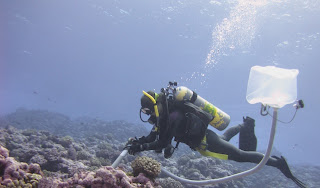Imagine that you are a scientist diving on a coral reef… what types of organisms would you choose to study? Many different life forms probably come to mind, including fish, invertebrates, and of course the corals. However, these are all macroorganisms (“macro” meaning large). In other words, these are organisms that can be seen with the naked eye. What you may not realize, is that an incredible diversity of life also exists at the microscopic scale. In fact, in one drop of seawater there are on average 1,000,000 individual bacterial cells! If that figure isn’t amazing then try one billion viruses per drop! That means that in just a few milliliters of seawater there are more viruses than there are humans on planet earth! Don’t worry, most of them are bacteriophages, viruses that only infect bacteria.
There are, however, some marine viruses that cause disease in reef macroorganisms. Did you know that corals get tumors, a growth anomaly that may be caused by viruses in the family
Herpesviridae? Don’t get me wrong, in a healthy reef ecosystem, viruses and microbes play beneficial roles. The coral reef food web is structured so that energy and materials flow from the microbes to macrobes, and back again. Therefore, both viral and bacterial communities are essential components of any healthy reef system.
One of the biggest and most pressing questions that coral reef scientists are currently trying to understand is: How do the combined effects of pollution, overfishing, and climate change result in degraded coral reefs? One way to start is to determine if both groups of organisms (macrobes and microbes) function and interact differently on healthy versus degraded reef systems.
To answer this bigger question, we must start by asking relatively simple questions. How many bacteria and viruses are there on a healthy versus a degraded reef? Are the types of microbes and viruses inhabiting the water column above a healthy reef different from those inhabiting a degraded reef? The first question involves capturing the bacteria and viruses on a filter, staining the filter with a fluorescent-dye that binds to DNA, and finally visualizing the filter with a fluorescent light microscope. The result looks like the night sky! Luckily the microbes and viruses are counted by a computer program.
 |
| Microorganisms vs. Macroorganisms |
So who’s there? Good guys or bad guys? Answering this question involves a technique called DNA sequencing. DNA from inside the viruses and bacterial cells is purified and the genetic material can then be replicated. When there are enough copies of the DNA, a machine literally reads the base pairs in the DNA sequence. If the DNA sequences match a known sequence in a master database, the microbe or virus that it came from can be identified. Typically, only a portion of the sequences actually “hit” something in the database. This means that the majority of microorganisms and their genes are still waiting to be discovered. But with each water sample we get closer to understanding this complex web of microscopic interactions on the reef.





.jpg)

Uh... isn't your diver in the "Collecting water samples" picture STANDING ON THE REEF (and killing coral)??
ReplyDeleteThank you for your comment. You observation is very perceptive and is exactly the type of thing that we want people to be concerned about during their dives The perspective of the photograph is unfortunate; in this case the diver is actually about 3 ft above the coral. In a typical benthic sample collection you would see a diver nearly upside down with their fins pointed toward the surface. This does two things, first it minimizes risk to the coral and second, it ensures that the sample is not contaminated with sediment kicked up by the diver.
ReplyDeletethis is a cool website and i like because i am from american samoa.......
ReplyDelete